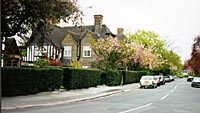 At this point, a row of houses intervenes between Wildwood Road and the Heath
Extension: numbers 1-15, the first to be built in the road and designed by
Sutcliffe (or an assistant of his). They are composed in pairs, with the same lively mixture of brick and half-timber, and intricate recessions and projections, as at Turner's Wood.
At this point, a row of houses intervenes between Wildwood Road and the Heath
Extension: numbers 1-15, the first to be built in the road and designed by
Sutcliffe (or an assistant of his). They are composed in pairs, with the same lively mixture of brick and half-timber, and intricate recessions and projections, as at Turner's Wood.
Opposite there are some more excellent neo-Georgian houses of the 'twenties. Number 48 is a fastidiously restrained house of the James type, designed by Robert Atkinson, the then principal of the Architectural Association School of Architecture, who unlike James, later joined the Modern Movement. Number 54, originally called The Court House, is a cleverly planned L-shaped bungalow by Evelyn Simmons, who had been the partner of one of the leading pioneers of neo-Georgian, Horace Field. The porch in the angle leads to an octagonal dining room with a single large music room filling the right hand wing. Numbers 56-60 are another group by James, a hipped-roofed house of the same restrained type as Fairway Close, flanked by two others, distinguished by a large arched window over the front door.
A number of interesting houses in dark brick are carefully composed around the junction with Kingsley Way where Wildwood Road turns at right-angles towards the centre of the Suburb. Numbers 19-23 are by Paul Badcock, working on his own (not for Soutar); Number 23 (1920-1) was his own house and like number 17 has intricate detailing in handmade Daneshill bricks -admirably matched in a recent extension. Numbers 19-21, designed with F W Knight, are tile-hung and informal. Across the road, numbers 62-64 (1924) are by Matthew Dawson, and have a big polygonal bay designed to be seen from a distance down the north-western arm of Wildwood Road. On the left, the Heath Extension is exposed again, with a long raking view up the Great Wall, with which Unwin brilliantly separated the urban centre of the Suburb from the rural landscape of the fields and hedgerows of the Heath Extension. But for the First World War, the Great Wall should have reached Wildwood Road.
|





